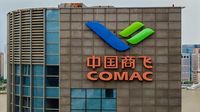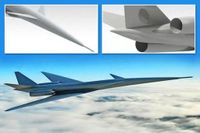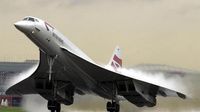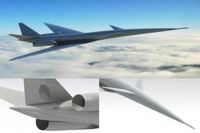China's state-owned aircraft manufacturer, COMAC, has unveiled ambitious plans for the C949 supersonic jet, aiming to revolutionize air travel with enhanced speed, range, and significantly reduced noise levels. This new aircraft is designed to fly at speeds exceeding 1,200 mph, making it a formidable competitor against the now-retired Concorde, which was once the epitome of luxury air travel.
The C949 is expected to have a remarkable range of 6,800 miles (10,944 kilometers), a substantial increase from the Concorde's 4,500-mile (7,242 kilometers) capacity. This range enhancement is expected to allow for direct flights from Shanghai to Los Angeles in approximately five hours. The C949's engineers have set a goal of reducing sonic boom noise to around 83.9 dB, comparable to the sound of a hairdryer. This is a significant improvement over the Concorde, which was notorious for its loud sonic booms that restricted its flight paths to over oceans.
According to the South China Morning Post and reports from the journal Acta Aeronautica Sinica, the design of the C949 includes a long, needle-like nose that is engineered to split incoming shock waves into three gentler pulses, thereby minimizing the impact of sonic booms. Additionally, the aircraft will feature aerodynamic bulges near the engines, which will help scatter exhaust turbulence and further reduce noise levels.
Incorporating cutting-edge technology, the C949 will also be controlled via artificial intelligence (AI) through a fly-by-wire system. This innovation is intended to enhance stability and maneuverability, particularly in extreme flight conditions. Furthermore, the aircraft is planned to include a mobile fuel system capable of holding 42,000 kg of fuel. This system will adjust the fuel tank's position during flight to maintain balance, a feature that could improve overall performance.
Designed to accommodate between 28 to 48 passengers, the C949 will offer a more intimate flying experience compared to the Concorde, which could seat up to 128 passengers. This shift towards a smaller capacity reflects a strategic decision to target the business-class market, emphasizing comfort and exclusivity.
In response to the C949's announcement, Blake Scholl, CEO of Boom Supersonic, took to social media platform X (formerly Twitter) to share his insights. He noted the significance of Ryanair's interest in COMAC's C919 aircraft, which is positioned as a competitor to Boeing's 737 and Airbus's A320 families. Scholl commented on the challenges that COMAC faces in entering the supersonic transport market, especially given that established players like Boom Supersonic are already making strides with their Overture aircraft.
Scholl's remarks highlight the competitive landscape of supersonic aviation, where companies like Boom are pushing forward with their own projects. Boom Supersonic's XB-1 prototype has successfully completed test flights, laying the groundwork for the Overture, which aims to carry 64 passengers. Scholl emphasized that while COMAC's ambitions are noteworthy, Boom remains the only Western contender focused on reviving commercial supersonic flight.
As the C949 project progresses, it is important to consider the broader implications for the aviation industry. The introduction of supersonic air travel could reshape global travel dynamics, offering faster connections and redefining long-haul flight experiences. However, regulatory challenges remain, particularly concerning noise restrictions for overland flights.
COMAC's C949 is not the only ambitious project in the works. The company is also developing the C929 aircraft as part of a joint venture with Russia, which is expected to cater to the growing demand for narrow-body jets. Additionally, the C939, designed to carry up to 400 passengers, is in the pipeline, positioning COMAC as a serious competitor to major players like Airbus and Boeing.
China's Aero Engine Corporation is also making headlines with its development of the hypersonic Nanqiang No 1 jet, which aims to reach speeds six times faster than the Concorde. This project, initiated in 2019, signifies China's commitment to advancing its aerospace capabilities.
The C949's anticipated service date is set for 2049, a timeline that reflects the complexities involved in bringing such an advanced aircraft from concept to reality. While the project is still in the design phase, the potential impact on the aviation industry could be profound, especially as other countries and companies compete to establish their own supersonic and hypersonic technologies.
The return of supersonic travel could reignite public interest in air travel, offering a glimpse into a future where long-distance journeys are not only faster but also more comfortable and efficient. As the aviation world watches closely, the C949 represents a bold step forward for China's aerospace ambitions, potentially marking a new era in commercial flight.





